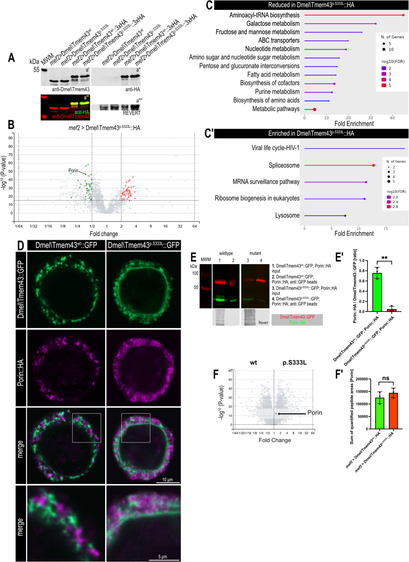📰 "Kenny mediates the recruitment of the phagophore for ubiquitin-dependent mitophagy in Drosophila neurons"
https://doi.org/doi:10.1091/mbc.E25-05-0235https://pubmed.ncbi.nlm.nih.gov/41259153/ #Mitochondria #DrosophilaKenny mediates the recruitment of the phagophore for ubiquitin-dependent mitophagy in Drosophila neurons | Molecular Biology of the Cell
The maintenance of healthy mitochondria is essential to neuronal homeostasis. Mitophagy is a critical mechanism that degrades damaged mitochondria, and disruption of this process is associated with neurodegenerative disease. Previous work has shown that mammalian optineurin (OPTN), a gene mutated in familial forms of amyotrophic lateral sclerosis (ALS) and glaucoma, is an adaptor to recruit autophagy machinery to mitochondria for ubiquitin-dependent mitophagy in cultured cells. However, OPTN's role in neuronal mitophagy in vivo remains largely unknown. Here, we demonstrate the Drosophila autophagy adaptor gene Kenny, a homolog of OPTN, mediates the recruitment of the phagophore to mitochondria undergoing ubiquitin-dependent mitophagy. We find that Kenny colocalizes with ubiquitinated mitochondria targeted for autophagic degradation in larval motoneurons, and is concentrated on the mitochondrial surface in areas opposed to the phagophore. Removal of Kenny in conditions of induced mitophagy eliminates the recruitment of the phagophore to ubiquitinated mitochondria and decreases mitophagic flux. In basal conditions, loss of Kenny causes accumulation of ubiquitinated mitochondria in neurons, indicative of stalled mitophagy. These phenotypes were reproduced in Kenny mutants ablating the LC3-interacting region domain. Overall, this work establishes Kenny as a functional homolog of OPTN in flies, and a mediator of neuronal mitophagy in vivo.
From Tanzania to the lab: hunting with hunter-gatherers reveals how periods of feast and famine can actually trigger a system of conservation & repair.
Follow @biohackingpathway for more
#HunterGatherer #Tanzania #FastingBenefits #CellularRepair #Mitochondria #BloodSugarControl #InflammationReduction #WellnessJourney
📰 "Micro-/nano-plastics accentuate Parkinson's Disease-relevant phenotypes in a Drosophila model"
https://www.biorxiv.org/content/10.1101/2025.11.17.688805v1?rss=1 #Mitochondria #Drosophila #Sleep
Natural compound rejuvenates aging cells in just 28 days
Researchers have demonstrated how a secret weapon made in the gut, produced by consuming foods like pomegranate and walnuts, can rejuvenate the immune system in middle age, shielding us from cell damage, inflammation and chronic diseases including cancer.
📰 "The ARVC-5-associated protein TMEM43 controls mitochondrial energy metabolism by stabilising ER-mitochondrial contact sites"
https://doi.org/doi:10.1007/s00018-025-05942-zhttps://pubmed.ncbi.nlm.nih.gov/41236655/ #Mitochondria #Metabolism #Drosophila
The ARVC-5-associated protein TMEM43 controls mitochondrial energy metabolism by stabilising ER-mitochondrial contact sites - Cellular and Molecular Life Sciences
Arrhythmogenic right ventricular cardiomyopathy type 5 (ARVC-5) is a fully penetrant form of ARVC caused by the missense mutation in the gene TMEM43p.S358L. Despite extensive research, the molecular basis underlying the detrimental effects of TMEM43p.S358L still needs to be discovered. TMEM43 is a phylogenetically conserved protein. We previously analysed the Drosophila homologue (CG8111 or Dmel\Tmem43) to understand the protein's physiological relevance and the mutation p.S358L. Drosophila Tmem43 is localised at the ER/SR membrane and interacts with the outer mitochondrial membrane protein Porin/VDAC. This interaction is lost in a Tmem43p.S333L mutant that resembles the human p.S358L mutation. In addition, Tmem43p.S333L caused a breakdown in mitochondrial membrane potential and increased cellular reactive oxygen species, suggesting impaired mitochondrial function as a major pathomechanism. Complementary ultrastructural analyses revealed severe structural defects in the affected mitochondria, including degeneration of the organelles. Highly similar ultrastructural defects were observed in the human right ventricular myocardium of a TMEM43p.S358L trait carrier, suggesting a common molecular basis for the detrimental effects of the mutation in flies and humans. We propose that both the p.S358L mutation in humans and the p.S333L mutation in Drosophila impair TMEM43/VDAC interaction, which affects the stability of ER/SR-mitochondrial contact sites and, thus, proper mitochondrial function and oxidative phosphorylation rates. The consequential undersupply of ATP likely results in cardiac cell death and, ultimately, heart failure.
📰 "Synergism of IP3R and Parkin mutants identifies mitochondrial stress as an early feature of Parkinson's Disease"
https://doi.org/doi:10.1242/dmm.052146https://pubmed.ncbi.nlm.nih.gov/41235839/ #Mitochondria #Drosophila📰 "Trehalose-mediated activation of Mitf corrects autophagy defects and ameliorates neurodegeneration in MPS VII"
https://www.biorxiv.org/content/10.1101/2025.11.10.687576v1?rss=1 #Mitochondria #Drosophila📰 "Brain lipidomics identifies mitochondrial redox dysfunction and metabolic trade-offs associated with Parkinsons disease-like pathology induced by Nanoplastics exposure"
https://www.biorxiv.org/content/10.1101/2025.11.09.687439v1?rss=1 #DrosophilaMelanogaster #Mitochondria #Circadian #Metabolism #Drosophila #Behaviour
